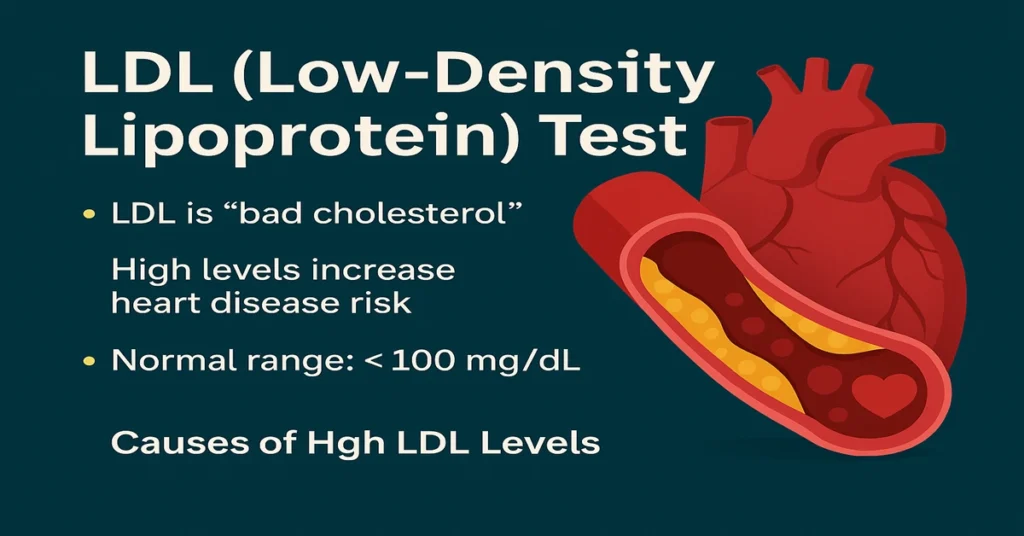What is LDL (Low-Density Lipoprotein)?
LDL stands for Low-Density Lipoprotein, often called “bad cholesterol.”
It is a type of cholesterol test that measures how much LDL cholesterol is present in your blood.
LDL is considered “bad” because when present in high amounts, it can deposit cholesterol inside your blood vessels. Over time, this causes plaque buildup (atherosclerosis), which narrows arteries and increases the risk of heart disease, stroke, and peripheral artery disease.
However, LDL is not entirely harmful. The body does need small amounts of LDL cholesterol for important functions like hormone production and Vitamin D synthesis. The real problem happens when LDL levels remain high for a long time.
Where is LDL Synthesized in the Body?
LDL is produced mainly in the liver as part of the body’s cholesterol transport system.
Here’s how it works:
- The liver first produces VLDL (Very-Low-Density Lipoprotein).
- VLDL delivers triglycerides (fats) to body tissues.
- After releasing most of its triglycerides, VLDL becomes LDL.
- LDL then carries cholesterol from the liver to different body cells.
So, LDL acts like a delivery vehicle for cholesterol — useful in limited amounts but harmful in excess.
Main Functions and Importance of LDL
Even though LDL is labeled “bad cholesterol,” it still plays essential roles in the body:
- Transports cholesterol from the liver to cells where it’s needed.
- Provides cholesterol for:
- Cell membrane structure (for healthy cell walls)
- Hormone production (like cortisol, estrogen, testosterone)
- Vitamin D synthesis (important for bones and immunity)
- Essential in small amounts, but too much causes artery damage.
⚠️ Key Point: Small amounts of LDL are necessary, but persistently high levels can lead to artery blockages and serious cardiovascular problems.
Causes of Low LDL Levels
Low LDL is less common but may occur due to:
- Hyperthyroidism (overactive thyroid)
- Chronic infections or long-term inflammation
- Liver disease or malnutrition
- Certain genetic disorders (e.g., abetalipoproteinemia)
- Medications like statins and fibrates that lower cholesterol
Symptoms of Low LDL
Most people with low LDL have no clear symptoms. Rarely, extremely low levels may cause:
- Fatigue or weakness
- Hormonal imbalance
- Neurological problems (rare)
- Increased risk of hemorrhagic stroke (bleeding in the brain)
Causes of High LDL Levels
High LDL cholesterol (hyperlipidemia) is one of the biggest risk factors for heart disease.
Common causes include:
- Unhealthy diet (saturated fats, fried foods, trans fats)
- Lack of exercise
- Obesity
- Smoking
- Genetic conditions (familial hypercholesterolemia)
- Hypothyroidism (underactive thyroid)
- Kidney diseases
- Diabetes mellitus
Symptoms of High LDL
High LDL usually has no symptoms at first. It is often detected only during a blood test.
But over time, high LDL can lead to:
- Chest pain (angina)
- Heart attack (myocardial infarction)
- Stroke
- Leg pain while walking (peripheral artery disease due to poor blood supply)
Reference Ranges (Normal Values)
(Numbers may vary slightly between laboratories)
| LDL Cholesterol Level | Category |
|---|---|
| < 100 mg/dL | Optimal |
| 100 – 129 mg/dL | Near Optimal |
| 130 – 159 mg/dL | Borderline High |
| 160 – 189 mg/dL | High |
| ≥ 190 mg/dL | Very High |
The lower your LDL cholesterol, the lower your risk of heart and artery disease.
Sample Type
- Sample Type: Serum
- Tube Used: Red Top (Plain Tube)
- Fasting Required: Yes, usually 9–12 hours before test
Test Preparation
- Fast for 9–12 hours before the test (only water is allowed).
- Avoid alcohol and high-fat meals for at least 24 hours.
- Continue regular diet before testing (sudden changes affect results).
- Inform your doctor about medications (e.g., statins, beta-blockers).
When to Consult a Doctor
You should consult a doctor if:
- Your LDL is above 130 mg/dL consistently
- You have risk factors like obesity, smoking, diabetes, or family history of heart disease
- You develop chest pain, fatigue, or stroke-like symptoms
- Your lipid profile shows high triglycerides and low HDL along with high LDL
Important Word Explanations
| Term | Meaning |
|---|---|
| Cholesterol | A fat-like substance essential for body functions, harmful in excess. |
| Plaque | A deposit of fat and cholesterol that clogs arteries. |
| Atherosclerosis | Hardening and narrowing of arteries due to cholesterol buildup. |
| Lipid Profile | A blood test that measures total cholesterol, LDL, HDL, and triglycerides. |
| Familial Hypercholesterolemia | A genetic condition causing very high LDL levels. |
~END~

